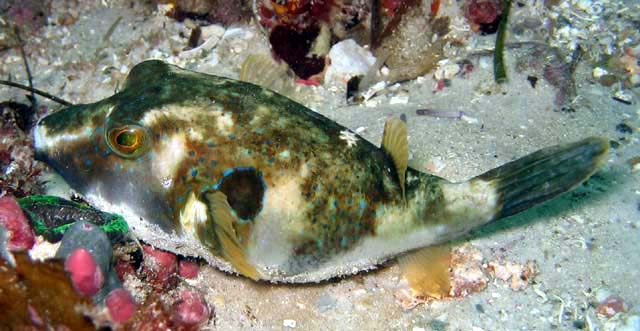In our recent article on rare dogface pufferfishes, we were able to cover every species except for the one which inspired the article. The image below is of an Australian pufferfish which has recently made its way to Blue Harbor in Japan, and we must admit we had no idea what it was at first.
The composition of this creature just screams “Arothron”, but which one? The blue spots bring to mind A. caeruleopunctatus, but the rest of the coloration is all wrong. After that, there’s nothing else even remotely close in appearance—could this be an undocumented Arothron endemic to Western Australia?

That seemed entirely implausible, so we enlisted the assistance of Dr. Glenn Moore, curator of ichthyology at the Western Australian Museum. It turns out we were barking up the wrong tree—this fish is Omegophora cyanopunctata.
Known by the common (and misleading) name “Bluespotted Toadfish”, this species is found along a small stretch of coastline from the southwestern shores of Australia—Rottnest Island near Perth in the west to Gulf St. Vincent in the east. It occurs at rocky reefs and manmade piers and jetties to a maximum depth of 25 meters and is regarded as a common inhabitant in this habitat.

It can be recognized by the eponymous blue spots which dot the back and sides of the animal, as well as an unusual dark spot ringed in blue above the pectoral fin base. This feature is reported to be a sexually dimorphic character found only in males. Maximum size for cyanopunctata is only 18cm, which makes this a perfectly pint-sized addition to a subtropical aquarium.
A second species in this genus, the “Ringed Pufferfish” O. armilla, has a more widespread range in Southern Australia, occurring from Botany Bay near Sydney in the east, south to Northern Tasmania, and west to Barrow Island and Ningaloo Reef. This means that the range of cyanopunctata is fully sympatric within that of armilla.

There are a couple possible explanations for how these two may have speciated: 1) O. armilla is reported from deeper reefs, to a depth of 146 meters, where it is frequently taken as bycatch in fishing trawls. This is clearly a different habitat than the shallow reefs its sister species favors, so perhaps ecological specialization is the cause of their divergence. 2) Given the unusual sexual color differences, which is a rare condition amongst pufferfishes, maybe sexual selection is to blame?

The Ringed Pufferfish can be identified by the black hemicircle above the pectoral fins, which occasionally develops into a ring which completely surrounds the fin base. Males of armilla are reported to sometimes have blue spots, nearly identical to those in its sister species, and they can reach a larger maximum size of up to 25cm.
Considering how similar these two taxa are, we can’t help but wonder if these are not in fact the same “species”. There are some minor differences in osteology and tooth counts which help further separate these two, but genetic study is surely warranted to decisively understand what is going on here.
Omegophora was created in 1934 for what was then Tetrodon armilla; the name can be translated as “omega-bearing”, in reference to the semicircular marking above the pectoral fins. Molecular study has indicated that this genus is sister to Arothron, which we suppose explains why we found it so easy to confuse the two.
One of the most obvious differences, albeit subtle, is the single flap above the nasal openings—Arothron has two. Furthermore, the frontal and prefrontal bones, which are situated in the roof of the skull between the eyes, are narrower and more truncated, though it’s difficult to see any outward manifestation of this. Other differences exist, but they involve abstruse minutiae of the internal anatomy best left to the brave souls devoting their lives to such masochistic study.

These faux-dogface puffers (née toadfish) are an interesting addition for those aquarists who like to keep things cool. If your 65°F fish tank is need of a little pizzazz, try adding one of these charming and rare pufferfishes. But good luck finding one!



